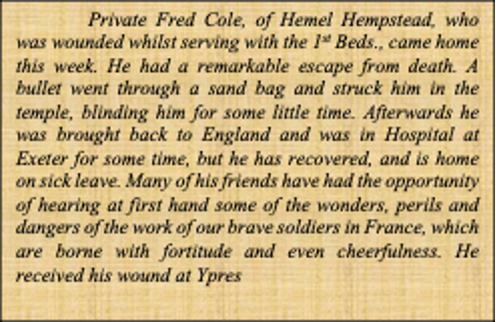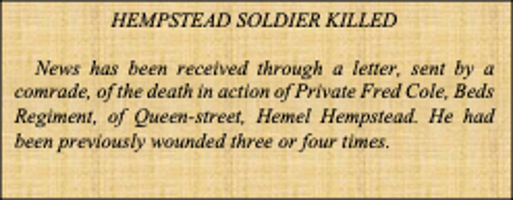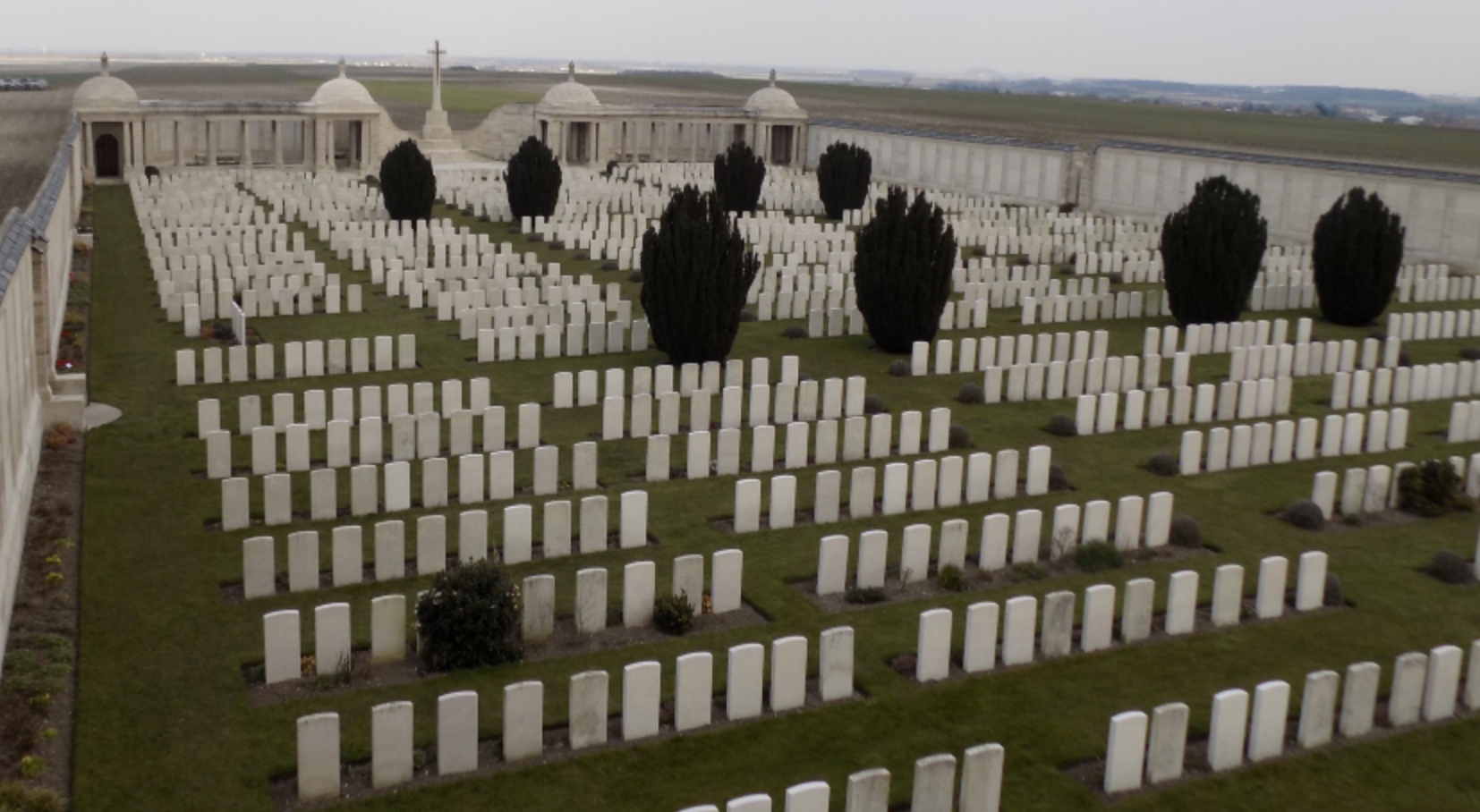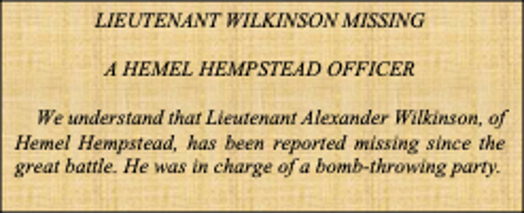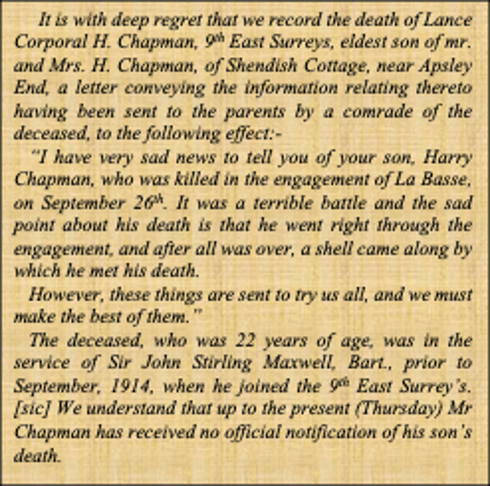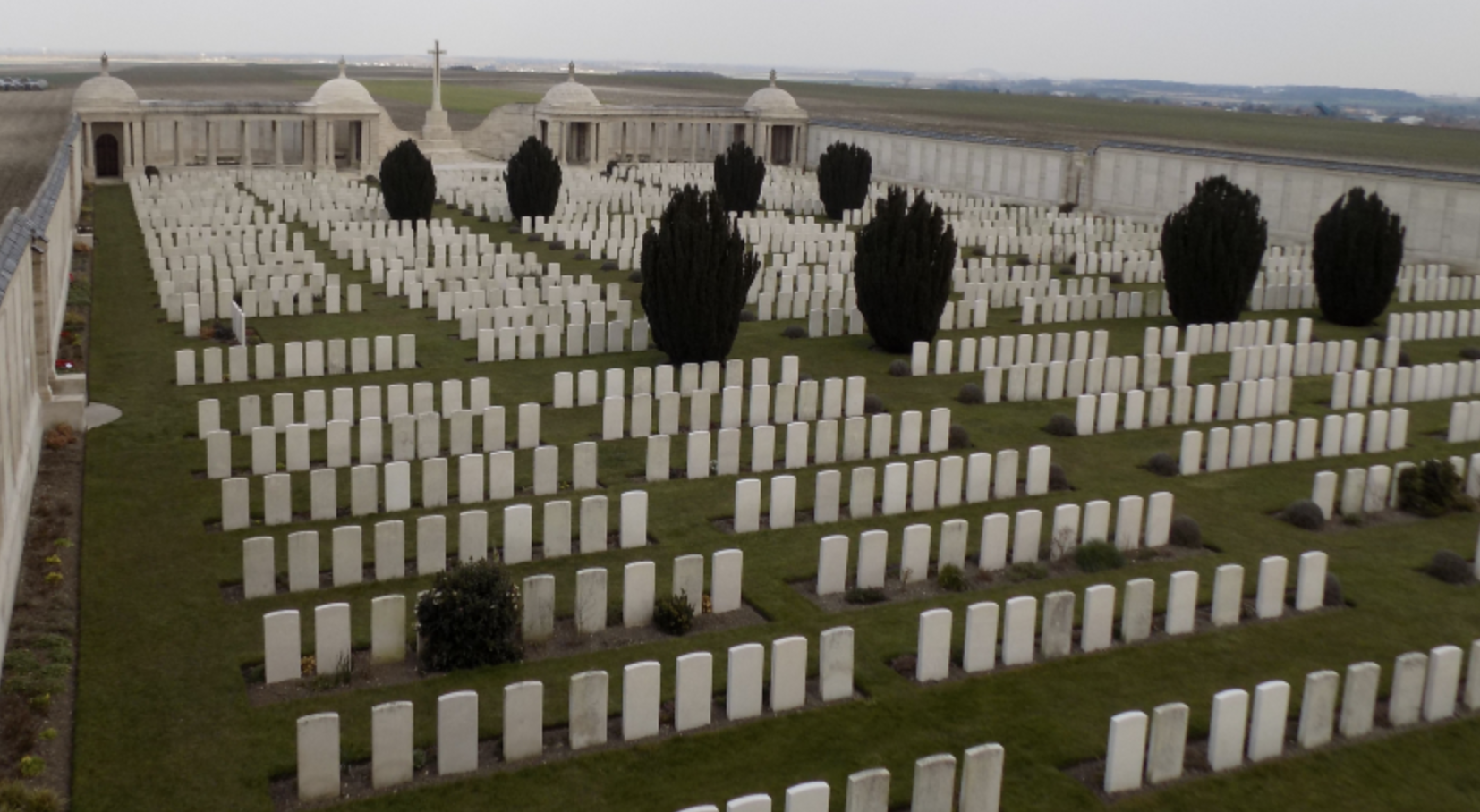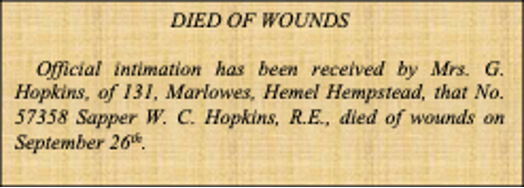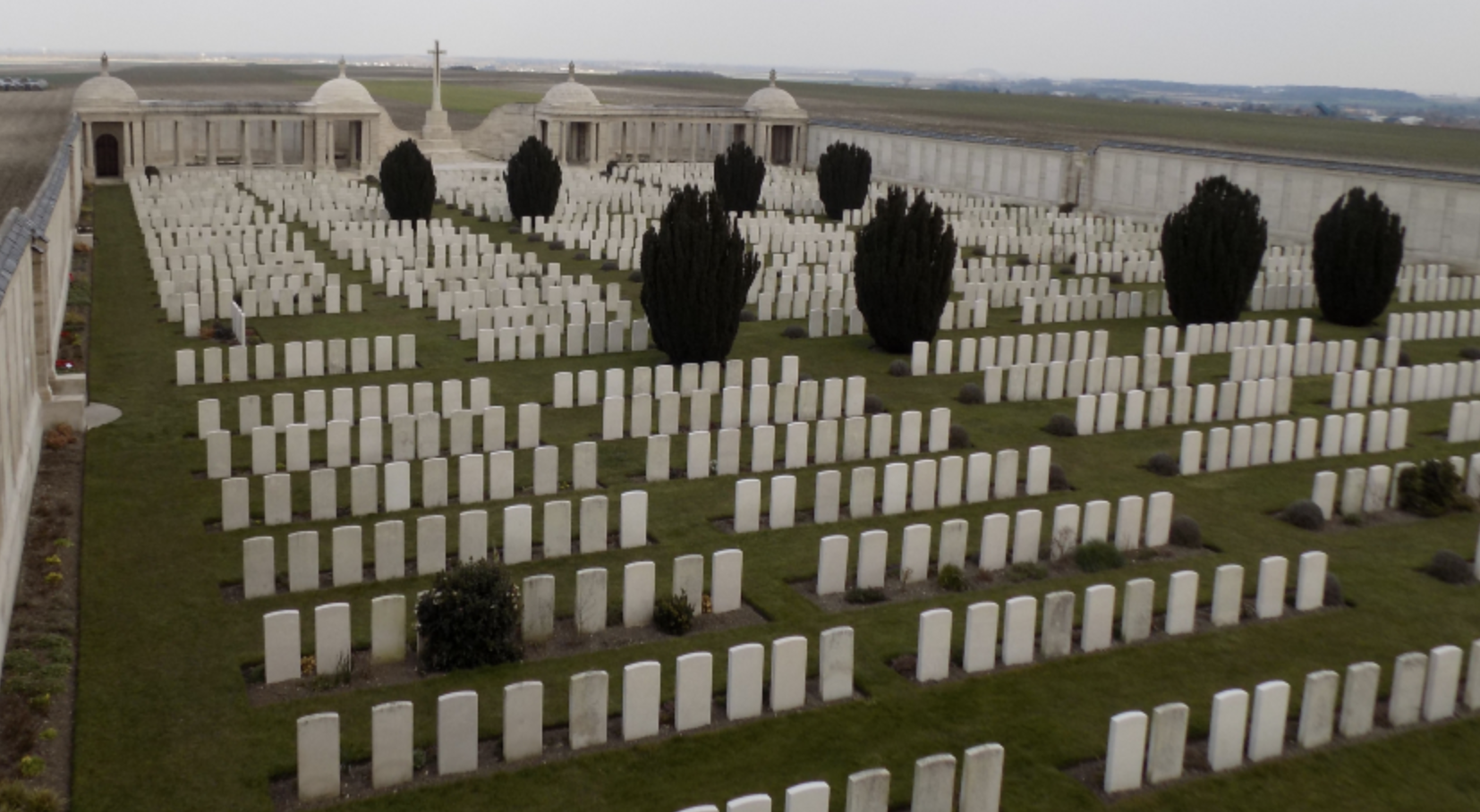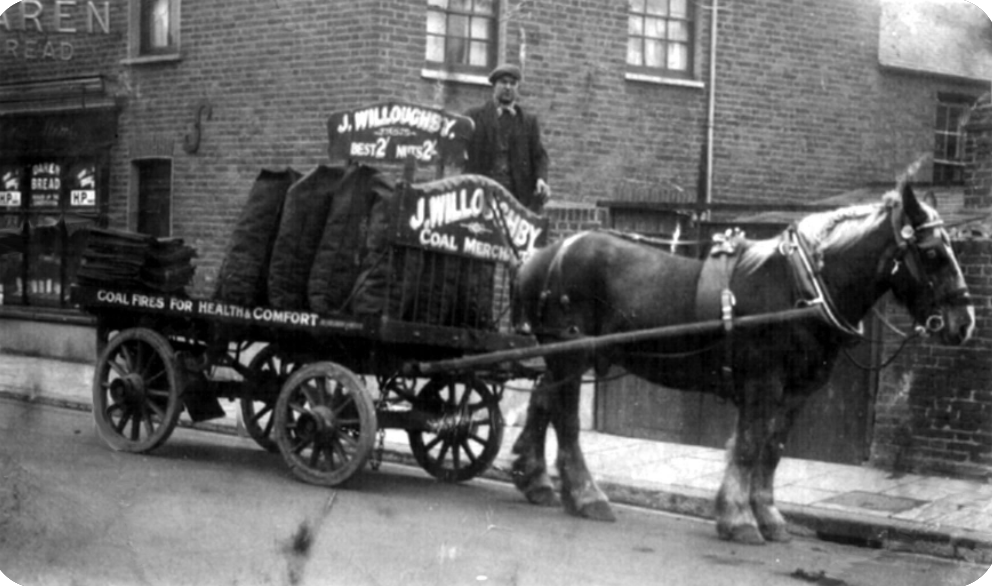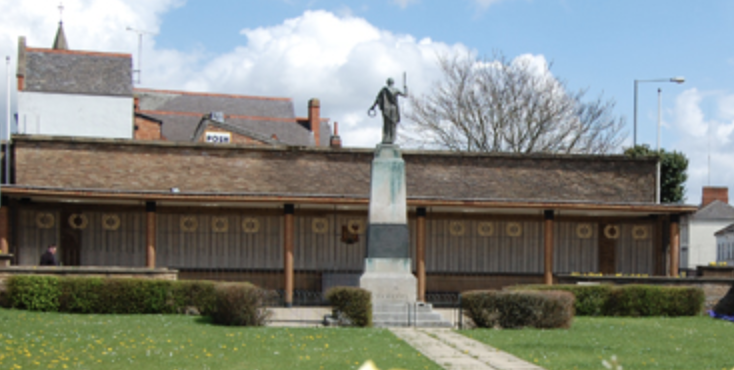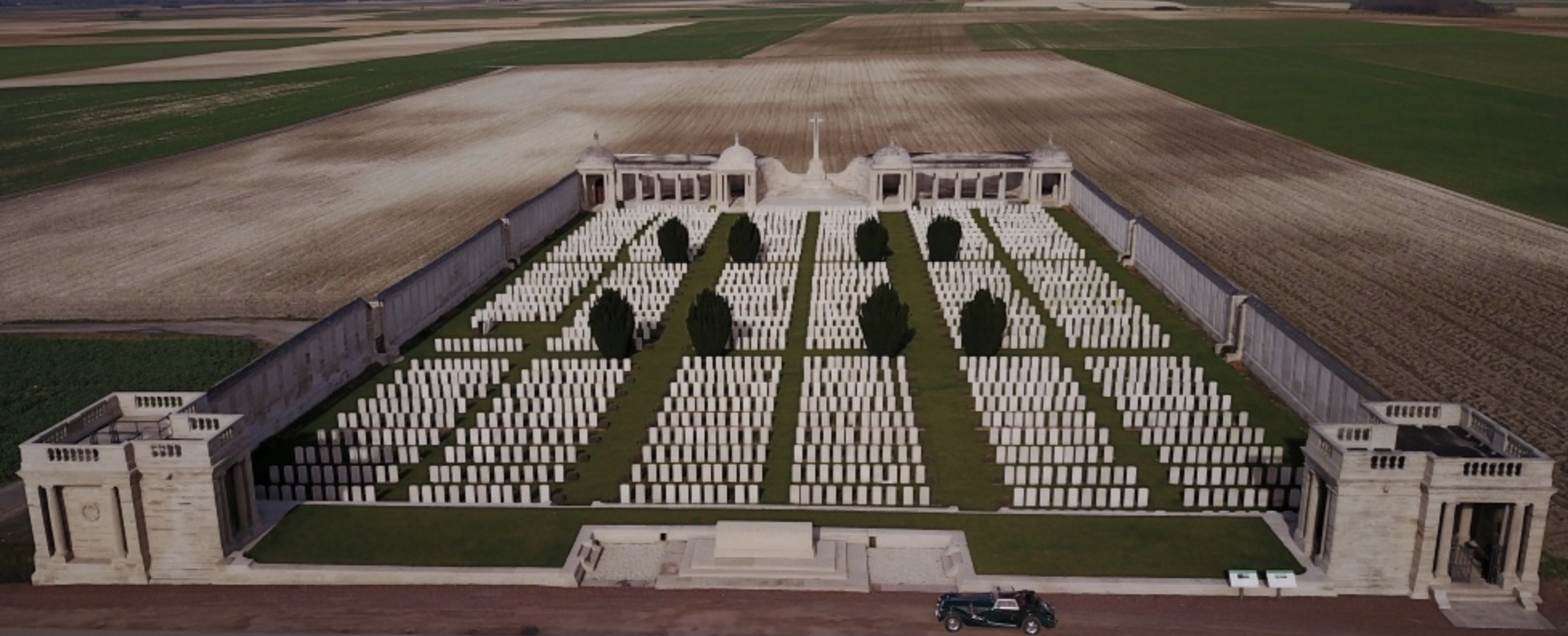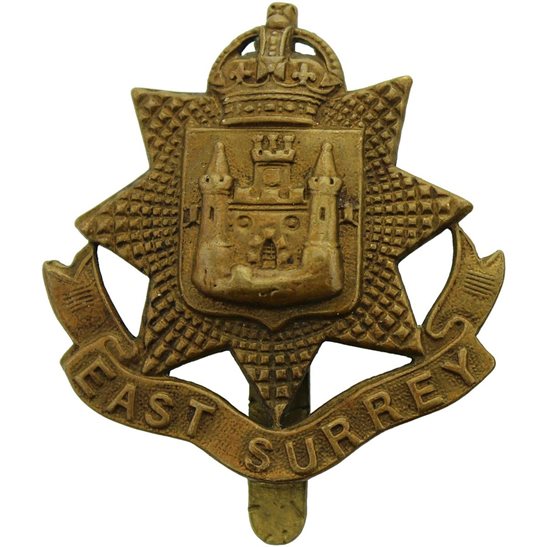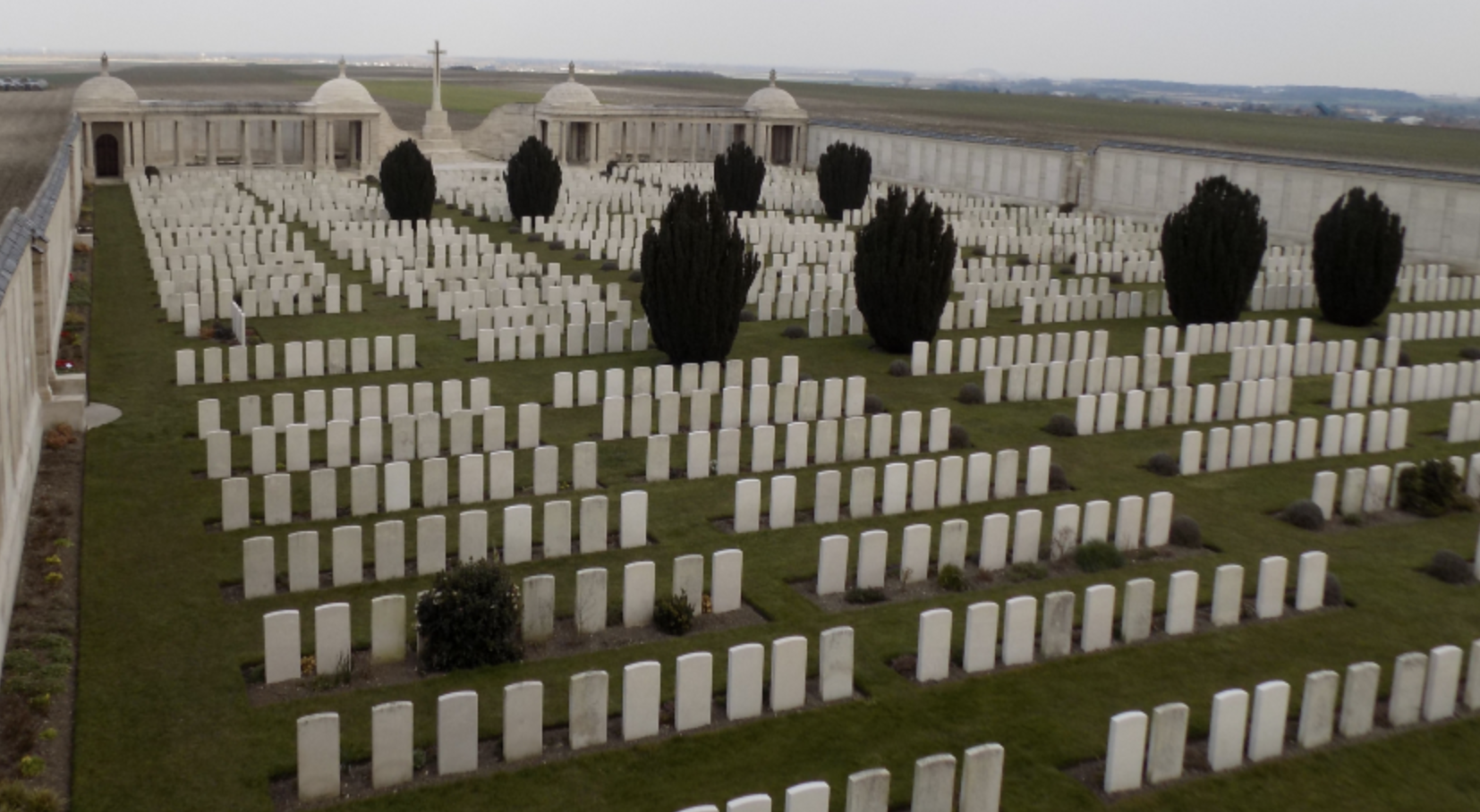Fallen in September 1915:
Frederick Cole
Ernest Alexander Wilkinson
Henry Chapman
Walter Cornelius Hopkins
Walter Parr
Robert Charles Benjamin Wright
FREDERICK COLE
4/7376 Private
2nd Bn., Bedfordshire Regiment
Killed in Action Saturday, 25th September 1915
Remembered with Honour, Loos Memorial, Pas de Calais, France, Panel 41 B
Frederick
Cole was born in Hemel Hempstead in the summer of 1884 and baptised on New
Year’s Day 1885 at St Paul’s Parish church in the town. His parents were George
Cole and Sarah Steers and Fred, as he was known, had nine brothers and sisters.
His older sisters were Kate Eliza, Elizabeth Matilda and Lillie and his younger
siblings were Nellie, Charles Ernest, Sarah Ann, Mary Polly, Sidney John and
Florence (known as Florrie). Kate died in 1900 aged twenty-two and the youngest
girl Florrie died in the same year shortly after she had been born.
Fred’s father George had worked as brickmaker in Leverstock Green but by the time Fred was born he had acquired a Threshing Machine and was working as an Agricultural Engine Driver, a job he would do until retirement. His job may have been the reason for the frequent home moves as George took on threshing work on the farms around Hemel Hempstead while the children grew up. The Coles lived at Leverstock Green, St Alban’s Road, Bennett’s End, Ebberns Road in Apsley, Church Street, and Herbert Street, before finally settling in Queen Street just after the outbreak of war.
In 1901 Fred aged sixteen was a ‘Striker’ in an Iron Foundry, a particularly tough and strenuous job. Sometimes known as a ‘hammerman’, the striker assisted a smith and would hammer on heated metal as the smith shaped the piece being made. By 1911 when the family lived at 12 Herbert Street, Fred was working as a General Labourer and had moved to John Dickinson & Co at Nash Mills where he remained until war broke out.
Fred attested at Hemel Hempstead at the end of August 1914 and enlisted with the Bedfordshire Regiment. As a new recruit he reported to the regimental depot at Kempston to be kitted out before heading for the Training Depot at Ampthill. On completion of training at the camp and having been passed fit for 'foreign service', he was initially posted to the 3rd Battalion at Felixstowe, before being quickly despatched to the 2nd Battalion and going to France.
Fred disembarked at Le Havre on the 11th November 1914 and entrained for Bailleul where he and ninety-nine other recruits joined their Battalion comrades on the 15th November. He spent time in the trenches throughout the rest of November, but he was wounded sometime before the famous ‘Christmas Truce’ occurred.
The Battalion War Diaries record the following "25 Dec 1914 Christmas day. "The Truce". The following is the substance of a report forwarded by C.O. to Brigade H.Q. "On evening of 24th Dec.1914 at about 8 p.m. the Germans were singing in their trenches. There were numerous lights on their parapets apparently on Christmas trees. A voice shouted from their trenches & could be distinctly heard "I want to arrange to bury the dead. Will someone come out & meet me"."
Then on Christmas Day the following: "This morning 25th inst. at 10 A.M. a German officer and 2 men unarmed came out of their trenches with a white flag and were met by Captain H. C. Jackson and asked to be permitted to bury their dead so we said we would not fire till 11.30 A.M. to give them time & this was done."
Finally: "During the period that no firing was taking place one of my Company Sergeant Majors was speaking to a German when an elderly officer passed. The German said he was the "Divisioner". This German also said they were very comfortable in a nice village behind but did not give the name! He seemed surprised that our troops were not an elderly Reserve class. The general impression was that the Germans had had enough and were anxious for the War to come to an end."
Fred by
this time had been hospitalised and his ‘lucky escape’ and serious wounding were
reported in the Hemel Gazette in February when he was recovering at home. (see extract)
On his
return to the Front in the spring of 1915 he took part in the Battle of
Festubert before being wounded for a second time in June, a fact again reported
in the Hemel Gazette. (see extract)
Misfortune followed Fred back to the Front and only a month later he was reported wounded for a remarkable fourth time although his mother refuted one of the incidents saying she had received a letter from him saying “that he was all right”. Regardless, Fred had suffered three wounds, one serious, in the nine months he had been at the Front. Tragically however, things were to get worse.
By the 16th September Fred was with the 2nd Battalion in the trenches at
Vermelles, six miles south east of Béthune as preparations for the next major
offensive progressed. The Battle of Loos started on the 25th September
and lasted until the 8th October 1915. It was the biggest British
attack of that year and the first time that the British used poison gas. It was
also the first mass engagement of Kitchener’s New Army units. It was an effort
to break through the German defences in Artois and Champagne and restore a war
of movement but despite improved methods, more ammunition and better equipment,
the British attacks were contained by the German armies.
Fred Cole was killed on the first day of the attack at Loos on Saturday, 25th September 1915. The British forces advanced over open fields, within range of German machine guns and artillery and the resulting losses were devastating. The 2nd Battalion Bedfords suffered heavy casualties in the first few hours of the advance for a gain of a few hundred yards and in all the War Diaries record: "Casualties of other Ranks during 25.9.15 - 1.10.15. KILLED 45 MISSING 40 WOUNDED 270 – 355."
Fred Cole c 1912 (Courtesy: The Hertfordshire, Hemel Hempstead Gazette and West Herts Advertiser)
Extract from The Hertfordshire, Hemel Hempstead Gazette and West Herts Advertiser 20th Feb 1915
Extract from The Hertfordshire, Hemel Hempstead Gazette and West Herts Advertiser 26th Jun. 1915
Extract from The Hertfordshire, Hemel Hempstead Gazette and West Herts Advertiser 9th Oct. 1915
John Dickinson & Co. Limited War Memorial, Apsley End (Courtesy: Traquair Photography, 30th Aug. 2017)
Loos Memorial, Pas de Calais, France (Courtesy: CWGC)
The Battle of Loos led to Sir John French being replaced as Commander in Chief by Sir Douglas Haig and in all the allies suffered 59,247 casualties. This included an appalling 8000 out of 10,000 men in just four hours on the 26th September.
Fred’s death was briefly reported in the Hemel Gazette in the month after he was killed. (see extract)
He is commemorated on the John Dickinson & Co war memorial in Apsley.
Fred is Remembered with Honour at the Loos Memorial, Pas de Calais, France on Panel 41 B.
He was 31 years old when he died.
Fred was eligible for the 1914-15 Star, the British War Medal and the Allied Victory Medal.
ERNEST ALEXANDER WILKINSON
2nd Lieutenant
2nd Bn., Leicestershire Regiment
Killed in Action Saturday, 25th September 1915
Remembered with Honour, Loos Memorial, Pas de Calais, France, Panel 42.B.
Ernest
Alexander Wilkinson was born on Thursday, 22nd September 1892 and
baptised six weeks later on Saturday, 5th November at Christ Church,
St Albans. Known fondly as Alec he was the fourth son of Frederick John
Wilkinson and Anne Coleman and he had seven siblings. His brothers were;
Archibald Harrap, Felix Wilfred, Frederick Edward and William Donald. His
sisters were; Constance Attwater, Margaret Stella and Kathleen Grace. Three of
Alec’s brothers served in the Great War and the youngest William Donald, whose
biography appears on this site, died at the Somme on 14th November 1916.
Alec’s father Frederick was a Clerk to the Church Missionary Society (CMS). The CMS was founded in 1799 and was committed to three great enterprises: abolition of the slave trade, social reform at home and world evangelisation. William Wilberforce MP was among the founding members. Frederick’s job meant the family had moved frequently as the children were growing up before he finally settled near Croydon in Surrey.
In 1901 when Alec was eight years old, the family were living at St Mary’s in Elstree, Hertfordshire and all of the children, with the exception of Constance and the two youngest, were at school or university. By 1911 when the family lived in Warlingham near Croydon, Alec as an eighteen-year-old was still in full-time education and the only son still living at home.
Sometime before the start of the War both Alec and his family moved back to Hemel Hempstead and were living at George Street and it was from here that he volunteered for ‘overseas service’ in August 1914. Alec had joined the Territorial Force whilst at university enlisting with the 28th (County of London) Battalion, London Regiment (Artists Rifles).
Following the formation of the Territorial Force, the Artists Rifles was one of twenty-six volunteer battalions in the London and Middlesex areas that combined to form the new London Regiment. It became the 28th (County of London) Battalion of The London Regiment on the 1st April 1908.
The Artists Rifles was a popular unit for volunteers and in 1914 it was formed into three sub-battalions, with recruitment restricted by recommendation from existing members of the battalion. It particularly attracted recruits from public schools and universities; on this basis, following the outbreak of the First World War, a number of enlisted members of The Artists Rifles were selected to be officers in other units.
It was with the Artists Rifles that Alec began his officer training and on the outbreak of war he transferred to the Leicestershire Regiment joining ‘A’ Company, 2nd Battalion in France on the 26th October 1914 as part of the Indian Expeditionary Force, Garwhal Brigade in the 7th (Meerut) Division.
Alec first saw action at the Battles of La Bassee, then Messines and Armentieres in October and November 1914. After winter operations the Division next took part in the Battle of Neuve Chapelle in March 1915 and it was following this action that Alec was promoted 2nd Lieutenant on the 23rd March. The Battles of Aubers Ridge and Festubert followed in May and by late September 1915, Alec was with his comrades in support at Pietre, Mauquissart approximately nine miles from Loos.
On the
first day of the Battle of Loos the 2nd Leicestershire’s War Diaries
record events at Mauquissart as follows: "25th.
September 1915…At about 6.10a.m. the left were (sic) over the German parapet
and our flag was seen flying on their lines. The left went forward with such
dash that they outstripped the 2/3 Gurkhas and came in for a lot of fire from
rifles and maxim guns from our right. This caused a good many casualties
including all the officers and most of the N.C.O.s of “A” Company which
was the extreme left. Undeterred the men
went on, got over the uncut wire and reached the road with parties of the 2/8
Gurkhas and gained their objective."
Alec
Wilkinson was one of three 2nd Lieutenants listed as “missing and no trace, a fact reported in
the Hemel Gazette a week later. (see extract)
His death was subsequently confirmed officially as Killed in Action on Saturday, 25th September 1915.
Alec is Remembered with Honour at the Loos Memorial, Pas de Calais, France on Panel 42 B.
He was 23 years old when he died.
Alec was eligible for the 1914-15 Star, the British War Medal and the Allied Victory Medal.
2nd Lieutenant Ernest Alexander ‘Alec’ Wilkinson (Courtesy: IWM,Bond of Sacrifice - First World War Portraits Collection)
Mauquissart 25th Sep. 1915 – Extent of 2nd Leicestershires advance (Courtesy:Beckett, I., Bowman, T., & Connelly, M. (2017). The Western Front, 1915. In The British Army and the First World War. Cambridge: Cambridge University Press)
Extract from The Hertfordshire, Hemel Hempstead Gazette and West Herts Advertiser 2nd Oct. 1915
Loos Memorial, Pas de Calais, France (Courtesy: CWGC)
HENRY CHAPMAN
4403 Lance Corporal
"B" Coy. 9th Bn., East Surrey Regiment
Killed in Action Sunday, 26th September 1915
Remembered with Honour, Loos Memorial, Pas de Calais, France, Panel 65
Henry Chapman, known as Harry, was born in the village of Hindlip, Worcester in 1893, the oldest son of Henry Chapman and Alice Tranter. Henry and Alice had four more children; Annie, Frederick, Alfred Charles and Leonard. The births of the children corresponded with their father Henry’s employment opportunities as a Butler in large country houses.
Beginning
with Harry and Annie who were both born close to Hindlip Hall in
Worcestershire, where their father was Butler to the Allsopp Brewing family
from Burton. By the time of Frederick’s birth in 1896, Henry was working at
Broxton Old Hall, Cheshire for the Egerton family and when the two youngest
children were born, the family were living at Airlour Lodge, Wigton, Scotland.
Henry by this time was Butler at nearby Monreith House, the family seat of writer
and politician Sir Herbert Maxwell 7th Baronet.
Harry followed his father into domestic service and it seems Henry may have helped him gain his first position when he left school aged thirteen in 1906. His employer was Sir John Stirling-Maxwell, 10th Baronet of Pollok, a Scottish Conservative politician and Philanthropist and a cousin of Sir Herbert Maxwell. In 1911 eighteen-year-old Harry was living and working as a ‘Hall Boy’ at 21 Portland Place, the London home of Sir John and his wife Christina.
By this
time his father was Butler at Shendish Manor in Kings Langley, in service to
the Longman family owners of Longman Publishing.
Harry enlisted with the 9th East Surrey Regiment at Guildford in September 1914. The 9th were a Service battalion raised at Kingston-upon-Thames in September 1914 as part of K3 (Kitchener’s New Army) and it came under orders of the 72nd Brigade in the 24th Division. It moved initially to billets in Worthing but by April 1915 Harry was with the Battalion at Shoreham in West Sussex before finally moving to Blackdown, Aldershot two months later.
The Battalion was mobilised on 31st August 1915 and one day later Harry had disembarked at Boulogne in France. The 24th Division concentrated between Etaples and St Pol on the 4th September and a few days later marched across France into the reserve for the British assault at Loos.
On the 26th September, the day after the assault began at Loos, orders to attack the enemy's position at 11 a.m. were received. The regimental War Diaries recorded the action: "The attack was launched at 11 a.m. & was carried right up to the enemy's trenches but the wire not being cut it was impossible to get through the enemy's lines although several fruitless attempts were made The casualties were very heavy at this point chiefly owing to some machine guns which formed a heavy cross fire on our men. The order was then given for the Bde. to retire to the line of trenches from which it had advanced in the morning This retirement was carried out in orderly manner under heavy shell fire of all kinds & the trenches were lined & manned The enemy continued to shell very heavily until about 5 pm in the afternoon & many of the slightly wounded were wounded again or killed. The casualties numbered 14 Officers & 438 other ranks"
Harry survived the assault but was one of the men tragically killed by the shelling when the worst seemed to be over. He had only been in France for twenty-six days when he was killed.
His death
on Sunday, 26th September
1915 was communicated to his parents by a comrade in a letter and reported in
the Hemel Gazette a month later. (see extract)
Harry is Remembered
with Honour at the Loos Memorial, Pas de Calais, France on Panel 65.
He was 22 years old when he died.
Harry was eligible for the 1914-15 Star, the British War Medal and the Allied Victory Medal.
Airlour Lodge, Monreith, Wigton, Scotland - Harry’s home in 1901 (Public Domain)
21 Portland Place, Marylebone, London - Harry’s place of work in 1911 (Public Domain)
Extract from The Hertfordshire, Hemel Hempstead Gazette and West Herts Advertiser 23rd Oct. 1915
Loos Memorial, Pas de Calais, France (Courtesy: CWGC)
WALTER CORNELIUS HOPKINS
57358 Sapper
73rd Field Coy., Royal Engineers
Died of Wounds Sunday, 26th September 1915
Remembered with Honour, Loos Memorial, Pas de Calais, France, Panel 5A
Walter Cornelius Hopkins was born in the summer of 1884 in Chelsea, West London the eldest child of Eli Hopkins and Louisa Hambidge. The family lived at Pembroke Road, Chelsea when Walter was born, and his father Eli was working as a ‘Stationary Engine Driver’. Walter had seven siblings; Eleanor Mary Sarah, Emily Sarah, Arthur, William Eli, Stephen Henry, Edith Alexandra and Violet Ethel May. Both Eleanor and Arthur died young.
William
served as a Corporal with the Royal Army Service Corps and survived the War.
In 1891 the family of five lived in two rooms at 49 Pembroke Road sharing the house with another family of five also living in two rooms. Eli’s job meant that he most likely worked in a factory, mill or pumping station and was responsible for operating or ‘driving’ a static engine such as a steam pump or turbine.
By 1901 the family had moved to Watford via Willesden and Hoddesdon and lived on Brightwell Road a couple of streets away from present day Vicarage Road, home of Watford F.C.. Eli was working as a ‘Steam Roller’ Engine Driver whilst sixteen-year-old Walter was a ‘Flagman’ for a Steam Roller, no doubt working with his father. Walter and Eli would have been two thirds of the three-man crew required to operate a steam roller. Walter’s job entailed warning the public of the approaching locomotive and ensuring that the machine could negotiate the roads safely whilst not exceeding the stipulated speed limit of 12 miles per hour.
Around this time Walter met Gertrude (Gerty) Allum from Boxmoor near Hemel Hempstead. They were married on the 10th June 1905 and by the outbreak of war, Walter and Gerty had two children; Walter James born in 1907 and Dorothy May born in 1914. The family lived at 131 Marlowes in Hemel Hempstead. Walter by this time was working as an Engine Driver (Stoker) although his employer is not known.
On the 30th November 1914, Walter attested at Watford and enlisted as a Sapper in the Royal Engineers. On enlistment he was 30 years old and is described as five feet seven and three quarter inches tall, weighing nine stone and his physical development was ‘Very Good’. His civilian job meant he was also considered a skilled man in the army and passed as an Engine Driver before being was transferred to 73rd Field Company, R.E. on the 10th December 1914.
When the expansion of the army was sanctioned in August 1914, it required four Armies each of six Divisions to have two Field Companies each; that is, forty-eight new Field Companies. 73rd Field Company were part of K2 (Kitchener’s New Army) and allocated to the 15th (Scottish) Division.
Walter was sent to France on the 8th July 1915, entraining at Swindon at 4p.m. before sailing from Southampton at twelve noon the following day aboard the SS Chyebassa. He disembarked at Le Havre on 10th July and until the end of August worked around the Arras area in trench and fortification activities. In September the 73rd marched north to Mazingarbe to support preparations for the assault at Loos.
On the 25th and 26th September Walter was part of the assault on Hill 70, surviving the initial action on the first day but receiving serious wounds on the second. He did not recover from these and died at 46th Field Ambulance whilst being treated on Sunday, 26th September 1915. Walter’s Service Record states that he was initially buried at Bethune, but it appears that this cemetery was later destroyed by German shelling and the grave lost.
Gerty had
been told that Walter was wounded but, in desperation for news she asked her
employer, William Woodman of the Albion Steam and Water Mills, the corn mill on
Marlowes, to write to the authorities on her behalf to enquire about her
husband. Mr Woodman did so on the 11th October 1915 the same day
that Gerty was officially notified of Walter’s death. (see extract)
Following Walter’s death Gerty was awarded a pension of twenty-one shillings for her and their two children. She received confirmation of this from the War Office on the 15th April 1916 just days before two-year-old Dorothy tragically died.
Walter Cornelius Hopkins, c 1914 (Courtesy: Allum Family)
Extract from The Hertfordshire, Hemel Hempstead Gazette and West Herts Advertiser 23rd Oct. 1915
Walter Cornelius Hopkins - Commemoration Card (Courtesy: Allum Family)
Loos Memorial, Pas de Calais, France (CWGC)
Walter is Remembered with Honour at the Loos Memorial, Pas de Calais, France on Panel 5 A.
He was 31 years old when he died.
Walter was eligible for the 1914-15 Star, the British War Medal and the Allied Victory Medal.
WALTER PARR
7325 Lance Corporal
1st Bn., South Wales Borderers
Died of Wounds 26th September 1915
Remembered with Honour, Loos Memorial, Pas de Calais, France, Panel 52
Walter Frederick Parr was born in Burton-on-Trent, Staffordshire in 1884 and baptised on 20th November in Holy Trinity Church in the same year. He was the second son born to Walter Parr and Frances Sarah Ford Foster and his older brother was Herbert Henry. His father worked in the brewing trade in Burton as a Maltster but, not long after Walter was born, his mother Frances died leaving his widowed father to raise the two boys.
However, Walter remarried in 1890 and he and his new wife Mary Ann then had five children together. Young Walter’s half brothers and sisters were; Mary Jane Susan, Charles, Ernest William, Emily Margaret and the youngest Lilian. His half-brother Charles Albert also fought and died in the Great War on 3rd August 1917, his biography also appears on this site.
Following his father’s second marriage, Walter along with his parents and older brother Herbert, was living at 32 George Street, Chesham in Buckinghamshire and his father was plying his trade with T & J Nash, owners of Chesham Brewery. Nash acquired the ‘Anchor Brewery’ in 1890 and this resulted in Walter senior moving his family to Hemel Hempstead two years later to be near his new place of work.
The family settled in Bury Road but, sadly Walter’s father died in 1898 and his step-mother Mary Ann was suddenly left with five children aged under ten. Walter aged sixteen was still at home and no doubt took on much responsibility for his younger siblings. His mother worked as a Charwoman and to supplement the meagre household income, Walter enlisted in 1901 with the 4th Bedfordshire Regiment as a Militiaman as well as working as a Coal Carter. His service record shows that Walter gave his age as 18 years and 3 months on enlistment, two years older than he really was. The fact that he lied to ensure enlistment perhaps emphasises his family’s financial plight following his father’s death.
His brother Herbert married Daisy Wilson from Crouchfield, Boxmoor in 1905 and by 1911 Walter was living with them and their son Walter Herbert at 139 Marlowes in Hemel Hempstead. He was still working as a Coal Carter and had by this time completed his four years of service with the Militia. Later in 1911 he moved to Northampton to live and work and whilst there met local girl May Marvesley. Walter and May were married a year later in the town.
On the outbreak of war Walter, as a Reservist, volunteered for overseas service, this time enlisting at Hemel Hempstead with the 1st Battalion South Wales Borderers in August 1914. The following month, May gave birth to their daughter and only child Doris at 49 Robert Street in Northampton in the heart of the town’s Boot and Shoe making quarter. Shortly after this happy event, Walter was sent to France.
The 1st Battalion South Wales Borderers in the 3rd Brigade in the 1st Division, had gone to France in August as part of the BEF. Walter disembarked in France on the 10th November 1914 and joined his battalion at Zillebeke in Belgium on the 13th November.
The battalion War Diaries record the arrival and described a logistical dilemma; "13th Nov Zillebeke…draft of 196 men arrived at Bde. H.Q. Impossible to accommodate them in trenches that night so they were sent back to battalion ammunition reserve park about 1 Mile E. of YPRES". The draft of men finally joined their comrades the next day at 5 p.m.
Walter saw action at the First Battle of Ypres and the Winter Operations of 1914-15. In 1915 he fought at the Battle of Aubers before taking part in the Battle of Loos. On the 26th September Walter was with his Battalion at Hulluch 3 miles east of Vermelles preparing to attack the enemy trenches.
The Battalion’s War Diaries recorded the attack: "September 26th HULLUCH FIRING LINE…..The order for attack was SWB (South Wales Borderers) on the left, The R.H. in the centre and WELCH REGT on the right. The instant the leading platoons left the forward trenches, they were badly held up by machine guns in the houses and the Brigadier gave orders to “stand fast” – The R.H. were also held up, while the Welch reached the enemy’s line but were driven off. We lost 8 officers and 105 men"
Walter was one of the men who died in the assault on the 26th September 1915.
He is commemorated on the Abington Square War Memorial in Northampton, less than half a mile from where he and May had lived with daughter Doris. May sadly died in 1921.
Walter is Remembered with Honour at the Loos Memorial, Pas de Calais, France on Panel 52.
He was 31 years old when he died.
Walter was eligible for the 1914-15 Star, the British War Medal and the Allied Victory Medal.
Holy Trinity, Burton-on-Trent where Walter was baptised (Image: https://commons.wikimedia.org)
The Anchor Brewery, Hemel Hempstead c 1891
An Edwardian Coal Carter (Photo: Public Domain)
A group of South Wales Borderers in 1915 (Photo: Public Domain)
Abingdon Square War Memorial, Northampton (Photo: Traquair Photography)
Loos Memorial, Pas de Calais, France (Photo: CWGC)
ROBERT CHARLES BENJAMIN WRIGHT
10930 Private
2nd Bn., East Surrey Regiment
Killed in Action Wednesday, 29th September 1915
Remembered with Honour, Loos Memorial, Pas de Calais, France, Panel 67
Robert Charles Benjamin Wright was born in North Creake, Norfolk in 1898 to John and Ellen Wright. He was their second child and first son and Robert had ten siblings who were; Annie, the eldest, then Ellen (Nellie) Edith, Olive Agnes, George John, Winnie Mildred, Lily Amelia, Harry Leslie and Ernest Edward. Two other siblings died in infancy around 1905.
Robert and his sister Annie had been born in Norfolk just before his father John moved the family to Sutton in Surrey to take up a position as a Gas Stoker. By 1901 they are all living at 14 Montague Terrace on Collingwood Road in Sutton.
By 1911, the family had moved again but only a short distance to 10 Sorrento Road, Sutton which was less than a mile away. Robert now thirteen years old had just left school and started work with a local grocer as a Cellar Man. His father is still working with the local Sutton Gas Company as a Mechanical Stoker.
On the outbreak of war both Robert and his father enlisted. In his father’s case he attested at Sutton on the 29th August 1914 and enlisted with the Royal Garrison Artillery. John was just over thirty-eight years old and had previous service with the Prince of Wales Own Royal Garrison Artillery. However, his service this time was short-lived, and he was discharged on the 21st September 1914 having been declared medically unfit for service. He was diagnosed as suffering from chronic Bright’s Disease, a kidney disease frequently associated with diabetes.
Robert attested at Kingston-upon-Thames on the 13th August 1914 only nine days after Britain declared war on Germany. His enthusiasm to enlist meant that he falsified his date of birth and when he joined the East Surrey Regiment he stated his age as “18 years and 264 days” when in reality he was still only sixteen. Officially recruits had to be eighteen and would not be eligible for overseas service until they were nineteen, so Robert’s very specific statement of his age would make him eligible to join immediately and to go to the front in just over one hundred days.
It is
estimated that as many as 250,000 underage recruits enlisted and fought at the
Front in the Great War. The youngest, believed authenticated, was
twelve-year-old Sidney Lewis who fought at the Battle of the Somme in 1916.
Robert was accepted and was duly posted to the 3rd Battalion East Surreys at the training unit in Kingston-upon-Thames on the 14th August 1914. Following his basic training we was assigned to 2nd Battalion East Surreys and disembarked in France on the 16th March 1915 and joined his comrades four days later at Locre in Belgium.
The 2nd Battalion, part of the 85th Brigade of the 28th Division, was heavily engaged in the Ypres sector almost immediately after being moved up the line for the first time in January 1915. A and C Companies were almost annihilated and shortly after, C and D Companies suffered almost as badly. After only five days of fighting barely 200 men remained of the 1000, who had disembarked in France such a short time before.
Robert saw
action around Ypres during April and on the 29th he received a
gunshot wound in his right arm on what the Battalion War Diary records as; “A quiet day. Casualties six killed two died
of wounds seven wounded.” Robert went down the line for treatment and after
a short period of recovery was back at the Front. His wounding led to a
distressing communication to his parents and he was reported killed, before the
War Office corrected the error and wrote to his family in June 1915 to confirm
that Robert was still alive.
Their relief was short-lived however, and by September Robert saw action at the Battle of Loos. Four days after the start of the battle he was killed in action whilst counter-attacking the Hohenzollern redoubt. He died on Wednesday 29th September 1915.
East Surrey Regiment Cap Badge WW1
Hohenzollern Redoubt September 1915 (Courtesy:www.dmu.ac.uk)
Loos Memorial, Pas de Calais, France (Courtesy: CWGC)
Robert had never lived in Hemel Hempstead, but his mother and seven of his siblings had moved there in 1917 after his father had died. It is not clear why they moved to Hemel Hempstead but, by 1919 they lived at 18 Cross Street, as Cherry Bounce was known for a short time. Regardless, Robert’s mother Ellen ensured that he was commemorated on the town War Memorial which was dedicated in 1921
His name is incorrectly recorded on the war memorial and is carved as "Robert G.B. Wright" instead of "Robert C. B. Wright".
Robert is Remembered with Honour at the Loos Memorial, Pas de Calais, France on Panel 67.
He was only 17 years old when he died.
Robert was eligible for the 1914-15 Star, the British War Medal and the Allied Victory Medal.
